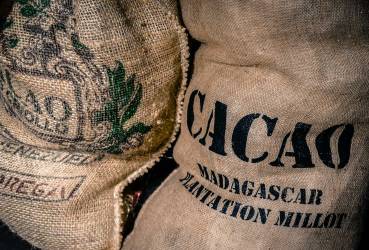ICE-traded cocoa futures (COCOA) are down nearly 4% today, pressured by rainfall forecasts in Brazil and Asia and weak bean grinding data that have sparked demand concerns across the market. The collapse in cocoa processing in Malaysia by 15% in Q1 2025 (according to the Malaysian Cocoa Board and Cocoa Manufacturers Group) and in Brazil by 13% (AIPC) signals weakening demand following last year’s sharp price rally. In 2024, cocoa prices tripled, which is now reflected in a global decline in demand for ‘expensive’ chocolate and its byproducts.
- As a result of surging cocoa prices, it has become extremely costly for chocolate producers and processors to replenish inventories. Supply shortages in the Ivory Coast and Ghana — the world’s top two producers — have complicated the market outlook for hundreds of companies in the industry.
- Shares of U.S. chocolate maker Hershey (HSY.US) are still struggling to recover from four-year lows.
- Last week, the world’s largest chocolate producer, Switzerland’s Barry Callebaut (BARN.CHN), reported falling sales volumes and cut its revenue guidance, citing the impact of high cocoa prices. Following the announcement, its shares dropped to their lowest levels in 14 years.
- Supply concerns remain, even though deliveries to Ivorian ports are running above last year’s levels, and cocoa inventories in exchange-monitored warehouses have climbed to their highest in over five months. Moreover, weather forecasts now point to returning rainfall in Ghana and Ivory Coast.
This scenario would ease fears of a difficult, dry season in West Africa. According to data gathered by Bloomberg, the rains are expected to bring much-needed moisture to key cocoa-growing areas, while seasonal rains in East African cocoa regions are supporting tree development. Heavier rains are also currently occurring in cocoa-growing regions of Indonesia and Malaysia, raising expectations for future supply improvements.
COCOA (D1)
Cocoa futures are down 4.3% today to $7,879, and a drop below $7,600 could open the way toward testing local lows from autumn 2024 near $6,295. Based on price action methodology, the next major resistance — supported by the 71.6% Fibonacci retracement of the 2024 rally — is located around the $8,200 area.

Source: xStation5
Daily Summary: Holiday Commodity Fever
ตลาดเด่นวันนี้: GOLD
ข่าวเด่นวันนี้: ดอลลาร์อ่อนค่าลง ขณะที่ราคาน้ำมันฟื้นตัวจากความตึงเครียดระหว่างสหรัฐฯ–เวเนซุเอลา
NATGAS ร่วงอีก 5% 🛢️ 📉 สภาพอากาศและปริมาณการผลิตเกินความคาดหมาย❗️


